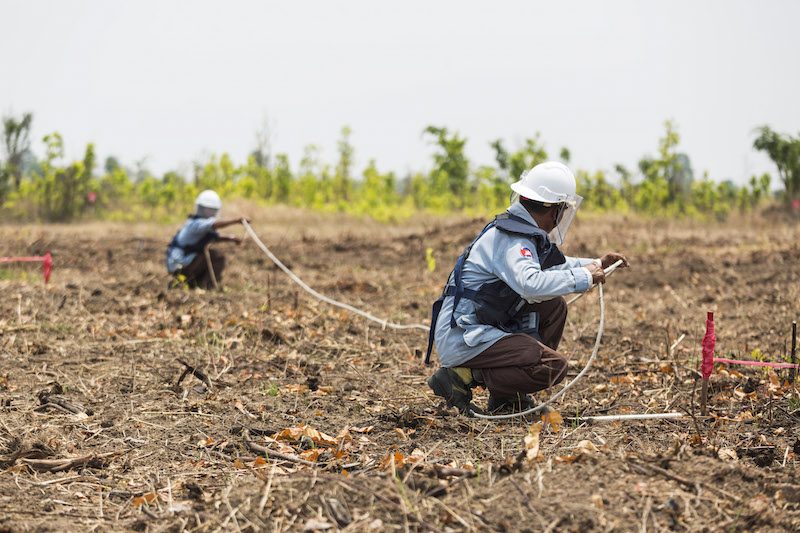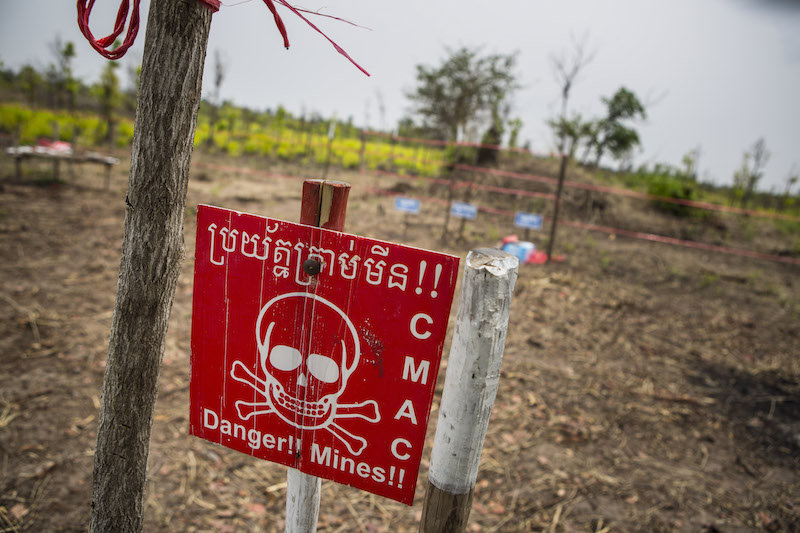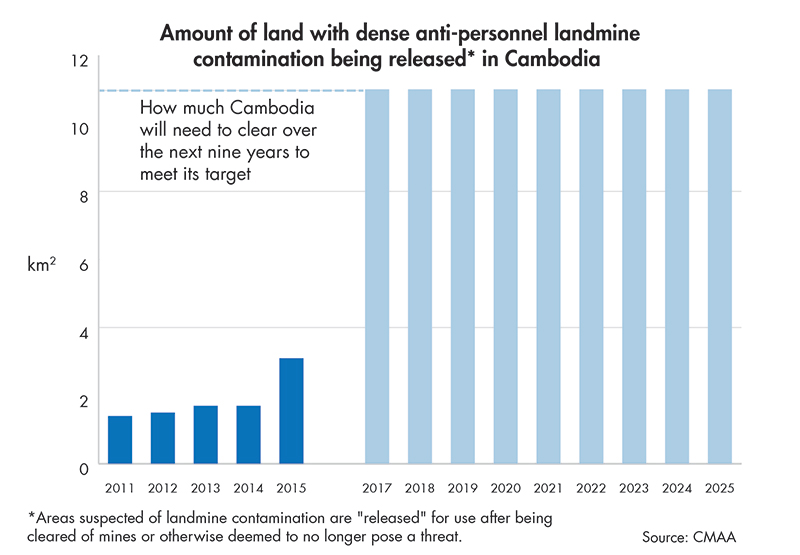Cambodia is on track to miss a critical 2025 deadline to clear its minefields because it is spending too much money and manpower on land with few or no mines, according to a new report that warns of “disastrous” consequences if the country fails to meet the target.
When Cambodia signed the U.N.’s Anti-Personnel Mine Ban Convention in 2000, it made a pledge to clear its anti-personnel mines over the next 10 years with the help of international donors. Far from the goal, it won an extension to 2019. With that target also out of reach, it is expected to get another extension to 2025.
But to meet it, the report says, Cambodia will need to significantly narrow and shift its focus to the densest and deadliest minefields, changes the government’s lead demining authority seems reluctant to make.
The Geneva International Center for Humanitarian Demining, which prepared the report for the U.N., describes 2025 as a “realistic” target. Of the nearly 1,000 square km of minefields Cambodia has left to clear—or otherwise “release” if it turns out there are no mines—only a tenth is classified as dense.
But as of now, the report says, “Cambodia is not in line with the 2025 goal” of clearing those dense minefields.
To get there, Cambodia has to clear an average of 11 square km a year of densely contaminated land over the next nine years. Over the last five years, however, it has averaged only 2 square km per year.
The rate is picking up, but it still cleared only about 3.1 square km last year. And nearly half that area “contained no, or a very limited number of, mines,” the report adds. “As many stakeholders told the review team, Cambodia should ‘stop clearing land with no landmines.’”
It says Cambodia is also spreading its deminers far too thin, across roughly 160 communes, even though over the past five years, just 35 of those communes accounted for 82 percent of mine casualties, or 266 of 323 deaths. (Old bombs and rockets killed or injured another 450.) The Geneva Center recommends prioritizing about 70 communes at most.
“There is no rationale to justify such a geographic dispersion of mine action assets, and it is believed that the mine action planning process is not sufficiently focused on what should be high priority areas,” it says. “By spreading its resources too thinly in too many and too large target areas, the sector minimizes its impact and extends the completion time.”
There’s nothing to stop Cambodia from continuing to clear its minefields after 2025. The fear is that the foreign governments bankrolling the great majority of the work—more than 80 percent of it—won’t stick around to help after being worn down by decades of support and pulled away by other global crises.
Current clearance rates and priorities “would still leave a significant anti-personnel mine contamination in Cambodia while, according to all credible hypotheses, the mine action program will be closed and Cambodia will be left alone to address it,” the report says.
With that in mind, it warns, “It would be disastrous to waste time and resources in areas with low contamination.”
International demining operators working in Cambodia agree.
In an interview earlier this year, Matthew Hovell, country director of the British mine-clearing NGO HALO Trust, urged deminers to “recalibrate” their priorities around the K5 mine belt, where better roads are attracting new villagers. Cambodian and Vietnamese forces laid down the belt along the Thai border in the 1980s in a bid to keep Khmer Rouge rebels holed up on the other side. They left behind what remains one of the most heavily mined strips of land in the world.

“We should be finished in another 10 years, but it’s going to need significant change with organizations who are very comfortable dealing with low-functional mines inside Cambodia [and who] need to get on this minefield if we’re to stand any chance of meeting that 2025 deadline,” Mr. Hovell said.
“Most of the sector’s efforts is going into possibly low-density …minefields. And we need to be getting on, as a sector, to the dense anti-personnel minefields, especially when you consider the fluid population movement, the new road going in. Otherwise there will be a massive spike in casualties.”
Besides actually clearing an area with deminers, a suspected minefield can also come off the contamination list if it’s been plowed by local farmers without incident for three years. It’s what deminers call “cancellation criteria.”
Mr. Hovell said the government was putting too many deminers on that kind of land, in part because of the U.N. Development Program’s (UNDP) Clearing for Results project, which funds most of the Cambodian Mine Action Center’s (CMAC) work in the west of the country. It was recently renewed for another four years.
“The UNDP Clearing for Results program is incredibly valuable to Cambodia. But, again, it needs to recalibrate its prioritization. A lot of the tasks that were published in Clearing for Results III this year, a lot of that stuff, if it was left, would reach cancellation criteria within the duration of the contract,” Mr. Hovell said. “If you’d just wait, that land would disappear off the database.”
“So as a sector we need to get our assets onto stuff that isn’t going to disappear with nothing. You don’t need to put clearance assets onto that sort of ground. The reason people are cultivating it is they know that it contains very few, a low likelihood of mines. And if there are mines there, then they’re not likely to function.”
Gregory Crowther, regional director for the Mines Advisory Group, another international demining operator, offered a few reasons for why that wasn’t happening: fear, and pressure to show progress.
The fear among some operators, he said, is that they’ll get blamed if an accident does happen in a field they decided to put aside for later because the risks of an accident were low—low but not nil. He said operators, the government’s in particular, feel compelled to prove how efficient they are by clearing lots of land, and the easiest way to do that is to clear land with few mines.
Mr. Crowther said some of the pressure to do that was coming from the foreign donor countries paying for the work.
“There is a need to demonstrate efficiency to maintain donor confidence, and donors have demanded that efficiency,” he said.
“Whether that’s the best way to demonstrate it, that’s the question. That probably isn’t the best way to demonstrate it. But donors are the ones that have said, ‘We want an efficient clearance program.’ But donors have to recognize that in densely contaminated areas…the demining process is slow and you don’t get hundreds of thousands of square meters or millions of square meters per year. It’s a slow and expensive process when you’re doing actual mine clearance.”
Mr Crowther suggested donors and operators focus more on other signs of progress. For example, they might pay more attention to bringing down the number of deaths and injuries from mines in the handful of the deadliest, densest communes.
But that also means accepting the risks of letting more people farm and move on to low-risk land. And as the report points out—and recommends—that means thinking about risk in a different way, for the operators and their donors alike.
“Can they change? I think they can, if they’re given the support to understand what does a risk management approach means,” Mr. Crowther said. “But if you’re a risk-averse government body, being told to accept risk and mitigate it…does require a change of mindset, and it will require support for them to feel confident that it can be done.”

Additionally, mine density cannot be the only driver, he said. A field with fewer mines might need more attention if, say, it’s on the edge of a village that locals are desperate to develop.
“If there’s a densely contaminated area in a commune with very few people and those densely contaminated areas are 5 km away from the nearest village, and there’s no actual plan currently to use them, to use that land for anything, than just because it’s densely contaminated doesn’t mean it should be at the top of the priority list,” he said.
The U.N. report keeps that in mind. Like a venn diagram, it recommends focusing on fields where mine density, the threat of accidents and the development demands of local communities converge.
“So there is some balance that’s required here,” Mr. Crowther said. “But on the whole, I think it’s true that the prioritization process needs to be reviewed if the country’s going to achieve its goal of 2025.”
The chances of achieving that goal at the rate Cambodia is going now, he said, were “very little to none.”
And to keep hold of another decade of support from donors who have already propped up the country’s demining work for one or two decades, he agreed, will take a real commitment from the government to get the job—or at least nearly all of it—done by 2025.
“That feels like more than long enough, and we know that even though Cambodia is developing economically, it’s not going to have the resources itself in the next five years to necessarily deal with the problem. So it does feel like this is the last push,” Mr. Crowther said.
That’s where Cambodia’s National Mine Action Strategy comes in.
The Cambodian Mine Action Authority (CMAA), which coordinates the country’s demining work, is in the midst of developing a new strategy for next year to 2025. It was supposed to be ready by June, but now the CMAA hopes to have a final draft ready for the start of the 15th meeting of states signed to the mine ban convention on November 28 in Santiago, Chile.
The U.N. report faults Cambodia’s current strategy for having clear goals and objectives, while lacking detailed plans on how to achieve them. CMAA Secretary-General Ly Thuch said the new strategy will fill in those gaps.
He agreed that operators needed to balance objectives. But unlike the international operators and the U.N. report, he disagreed with the need to rebalance.
“I think for the time being we are doing well,” he said. “There are operators who are more dynamic on more denser minefields. And then we need operators who…also work closely with the communities to clear landmines. So I think that we cannot say who did a better job. But I think that we need all of them, because our vision is to get rid of these mines and things by 2025.”
But not getting the government’s own demining operators behind the recommended rebalance could make that an especially tall order. Together, the Cambodian Mine Action Center and the National Center for Peacekeeping Forces, Mines and Explosive Remnants of War Clearance, a unit of the military, contribute more than 70 percent of the country’s demining staff.
Mr. Thuch acknowledged that the country had to pick up the pace, but was reluctant to concede that donors might start running out of patience if they can’t.
That patience may be waning already, however. The government’s CMAC, the country’s largest deminer, saw its operating budget fall from about $14 million in last year to $10 million this year, mostly because some international donors have pulled out. The reductions are forcing significant staff cuts by attrition at the same time that the center has had to move dozens of deminers to eastern provinces, away from where most of the mines are, because of changes in funding and strategy.
The country’s biggest demining donors right now are the U.S., U.K., Japan and Australia. The local embassies of all four countries declined requests for an interview.
According to the CMAA, the Cambodian government last year covered 17 percent of the costs of mine action work in the country, from demining to risk education to victim assistance. With national incomes growing and government revenue on the rise, donors say they want to see Cambodia make a solid commitment to paying for more.
Mr. Thuch said the new strategy was not likely to do that, but it could help convince the government to give more.
“From talks with my friends at the Ministry of Finance,” he said, “they continue to say, ‘Yes, your sector is a priority. No cut budget, but will be more budget in the future.’ So it is optimistic.”





